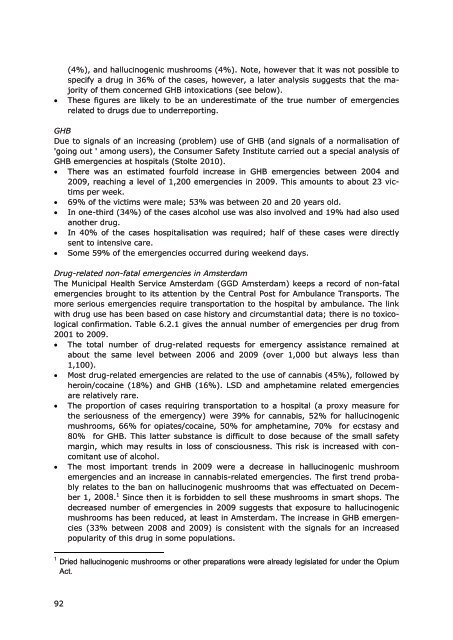The Netherlands Drug Situation 2010 - Trimbos-instituut
The Netherlands Drug Situation 2010 - Trimbos-instituut
The Netherlands Drug Situation 2010 - Trimbos-instituut
You also want an ePaper? Increase the reach of your titles
YUMPU automatically turns print PDFs into web optimized ePapers that Google loves.
(4%), and hallucinogenic mushrooms (4%). Note, however that it was not possible tospecify a drug in 36% of the cases, however, a later analysis suggests that the majorityof them concerned GHB intoxications (see below).<strong>The</strong>se figures are likely to be an underestimate of the true number of emergenciesrelated to drugs due to underreporting.GHBDue to signals of an increasing (problem) use of GHB (and signals of a normalisation of'going out ' among users), the Consumer Safety Institute carried out a special analysis ofGHB emergencies at hospitals (Stolte <strong>2010</strong>). <strong>The</strong>re was an estimated fourfold increase in GHB emergencies between 2004 and2009, reaching a level of 1,200 emergencies in 2009. This amounts to about 23 victimsper week. 69% of the victims were male; 53% was between 20 and 20 years old. In one-third (34%) of the cases alcohol use was also involved and 19% had also usedanother drug. In 40% of the cases hospitalisation was required; half of these cases were directlysent to intensive care. Some 59% of the emergencies occurred during weekend days.<strong>Drug</strong>-related non-fatal emergencies in Amsterdam<strong>The</strong> Municipal Health Service Amsterdam (GGD Amsterdam) keeps a record of non-fatalemergencies brought to its attention by the Central Post for Ambulance Transports. <strong>The</strong>more serious emergencies require transportation to the hospital by ambulance. <strong>The</strong> linkwith drug use has been based on case history and circumstantial data; there is no toxicologicalconfirmation. Table 6.2.1 gives the annual number of emergencies per drug from2001 to 2009. <strong>The</strong> total number of drug-related requests for emergency assistance remained atabout the same level between 2006 and 2009 (over 1,000 but always less than1,100). Most drug-related emergencies are related to the use of cannabis (45%), followed byheroin/cocaine (18%) and GHB (16%). LSD and amphetamine related emergenciesare relatively rare. <strong>The</strong> proportion of cases requiring transportation to a hospital (a proxy measure forthe seriousness of the emergency) were 39% for cannabis, 52% for hallucinogenicmushrooms, 66% for opiates/cocaine, 50% for amphetamine, 70% for ecstasy and80% for GHB. This latter substance is difficult to dose because of the small safetymargin, which may results in loss of consciousness. This risk is increased with concomitantuse of alcohol. <strong>The</strong> most important trends in 2009 were a decrease in hallucinogenic mushroomemergencies and an increase in cannabis-related emergencies. <strong>The</strong> first trend probablyrelates to the ban on hallucinogenic mushrooms that was effectuated on December1, 2008. 1 Since then it is forbidden to sell these mushrooms in smart shops. <strong>The</strong>decreased number of emergencies in 2009 suggests that exposure to hallucinogenicmushrooms has been reduced, at least in Amsterdam. <strong>The</strong> increase in GHB emergencies(33% between 2008 and 2009) is consistent with the signals for an increasedpopularity of this drug in some populations.1 Dried hallucinogenic mushrooms or other preparations were already legislated for under the OpiumAct.92




